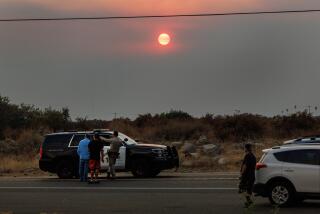Mexico City Gets a Breather After Crackdown on Smog : Environment: Even dogs cry amid ozone alert. Half a million cars are pulled off the roads, and plants cut output.
MEXICO CITY — How smoggy was it?
So smoggy, even the dogs cried.
So smoggy, the air smelled like gas.
So smoggy, the government closed the schools under an emergency plan put into effect for the first time on Tuesday after ozone readings hit a dangerous record high in southern Mexico City on Monday afternoon.
The government also pulled 500,000 more cars off the road-- double the number normally banned each weekday--and forced 200 of the city’s most polluting industries to cut production 50% to 75%. All but one company complied, city officials said.
The effect was a relatively traffic-free day, a lighter gray haze and a dramatic reduction in ozone readings Tuesday afternoon; this prompted the government to lift the emergency measures at 10 p.m.
Nonetheless, residents said they were frightened by the record ozone readings--similar to the worst of Los Angeles in the 1970s--and health experts warned of more to come.
“We haven’t hit bottom,” said Manuel Guerra, head of the Independent Institute for Ecological Research. “We are going to see higher concentrations yet because of the cars. This is very dangerous, especially for young children.”
Guerra said that Mexico City saw 350,000 automobiles added to its crush of 3 million vehicles last year; 80,000 new cars were sold here in the first two months of this year. Most cars still do not have catalytic converters to use unleaded gas. Some well-intentioned drivers, he said, have been using unleaded gas without the converters, which is worse for the environment than regular gas.
The alarming ozone reading on Monday afternoon was 398 points on Mexico’s Imeca scale, or 0.42 ozone parts per million. That is nearly four times the federal standard in the United States.
Guerra explained that the ozone peak resulted from “very high emissions for a few days . . . coupled with absolutely no movement of different layers of the atmosphere and very nice weather--a lot of sun--which creates a photochemical reaction . . . that creates ozone very rapidly.”
Bill Kelly, a spokesman for the Los Angeles Air Quality Management District, said in a telephone interview: “That is a high level like we were exposed to back in the 1970s. We haven’t been exposed to anything like that in the past 10 years. We had a .40 reading in 1982.”
Los Angeles would call a second-stage smog alert at .35 parts per million and a third-stage alert at .50 p.p.m.
By Tuesday afternoon, Mexico City’s highest ozone reading had dropped to about .15 p.p.m., still above the U.S. federal health standard. The improvement was credited to the emergency program and light winds.
Ozone is poisonous in large concentrations. In February, Dr. Margarita Castillejo, a researcher at the Autonomous University of Mexico, published a six-month study of 150 schoolchildren in southern Mexico City showing ozone’s short-term effects.
“The study observed a transitory decrease in the volume of air breathed, which is recouped when the ozone goes down. We also saw a very high increase in respiratory problems in this area,” she said.
Mexican federal and city governments have taken steps in the last three years to try to reduce the smog. Last year, President Carlos Salinas de Gortari closed a smoke-spewing oil refinery in a suburb of the capital. Mexico City Mayor Manuel Camacho has required motorists to leave their cars at home one day a week and ordered cargo trucks, buses and taxis to switch to alternative fuels or upgrade to newer cars with catalytic converters within four years.
But the effect has been minimal. Last month, Camacho commissioned a study of a proposal for giant fans to blow the smog away. The idea comes from opposition leader Heberto Castillo, an engineer and member of the Democratic Revolutionary Party. It has been dismissed by many as “hot air.”
“The atmosphere above Mexico City can’t regenerate itself,” said Guerra. “It needs huge wind currents, but not artificial ones. You shouldn’t tinker with the climate. You should work on the (gasoline) consumption.”
Whatever it is, residents are calling on the government to do more. Carmen de Agraz, a 60-year-old housewife in southern Mexico City, described Monday’s gray haze as “fatal. The whole house smelled like lead or gas or I don’t know what. It was choking.”
More to Read
Sign up for Essential California
The most important California stories and recommendations in your inbox every morning.
You may occasionally receive promotional content from the Los Angeles Times.










